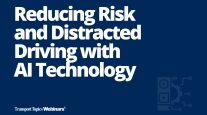CEO, Idelic
Perspective: Using AI to Reduce Turnover
[Stay on top of transportation news: Get TTNews in your inbox.]
Fleets searching for ways to find and retain safe drivers can find answers in their own data … if they know how to properly mine it.
Start by identifying inefficiencies in your system that could cause safety-based turnover. For example, a fleet may have driver safety data, but when it’s disorganized it becomes functionally useless. Telematics, training and human resources records are all valuable, but when spread across different platforms, important trends often are overlooked. Taking even small steps to organize and understand your data can help.
For fleets that aren’t already taking these steps, manual scorecarding, in particular, can be a useful way to evaluate driver performance. It’s as simple as picking three or four metrics you’d like to evaluate your drivers on, such as on-time delivery or accident avoidance, and checking boxes to see how well your drivers meet your selected criteria.

Cardiff
Fleets also should be calling drivers more regularly to get feedback and see if anyone is unhappy. All of these can reduce driver turnover by giving you a better picture of your drivers’ performance and by keeping them involved in your fleet.
Collating every department’s data into a single system or platform can help safety managers see all the data available to them and gain a better understanding of their drivers. This could mean uploading all of your data to a single driver-management platform or making sure your data is up to date across all your separate platforms, depending on the needs of your fleet.
Once fleet data is normalized, artificial intelligence technology can help safety managers make better use of it.
In its truest form, AI is a type of software that finds patterns in driver data and uses them to make predictions on an outcome. It does this by following a three-step process. First, it analyzes the data it is given and tries to predict whether something will happen. Then, it checks to see how accurate its prediction was. Finally, it teaches itself how to make better predictions based on what it predicted correctly and what it predicted incorrectly. It then repeats this process until its predictions are as close to accurate as possible.
AI software utilized for driver safety pulls in data about each driver from available sources — ELDs, telematics, HR, etc. — analyzes the trends, and then assigns each driver a score that represents the risk of them getting into an accident. AI accomplishes this by following the three steps above with the driver data it’s given. The AI will then alert the fleet’s safety team which of their drivers are most at risk, allowing them to intervene and pre-empt a potential incident.
Further, AI can look into each driver and identify why they’re at risk of getting into an accident by analyzing the specific risks they face, then recommend training to address their specific needs.
Reducing Voluntary Turnover
AI also can predict which drivers are most likely to leave a fleet voluntarily. For example, an AI program can look at key risk signs — like which drivers are taking routes the farthest from their home or who is initiating conversation the least — and then rank drivers based on their chance of leaving. A safety manager can then look at this data and take proactive steps to keep drivers engaged and excited to stay on board, like checking in more frequently or scheduling more manageable routes.
According to the Driver IQ Recruitment and Retention survey from the first quarter of 2018, nearly 40% of drivers cite a lack of communication as a reason for why they left their previous fleet. Technology can send automated text messages or emails to drivers to start discussions, creating easy and accessible engagement. There is even technology available that can remind managers to call their drivers on a haul or wish them a happy birthday. And all of that can be helpful, but technology alone can’t deliver the human interaction drivers are looking for. However, it can make a manager more effective.
Turnover is not only a headache for fleets, it’s expensive, too. American Trucking Associations reported that in the third quarter of 2019, turnover rates for large truckload fleets — those with more than $30 million in revenue — rose to an annualized rate of 96%. For most fleets, this onus is incredibly taxing to their operation. Fleets that want to lessen that burden need to consider how AI technology can help.
Hayden Cardiff is the founder and CEO of Idelic, the team behind the Idelic Safety Suite.
Want more news? Listen to today's daily briefing:




